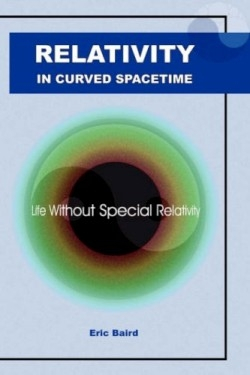Relativity in Curved Spacetime
Life without special relativity
“Every time we find a problem with general relativity, the reason why that problem exists turns out to be the same: it’s that things have to be that way in order to avoid creating conflicts with special relativity,” writes Eric Baird. Could special relativity actually be, well…wrong? In Relativity In Curved Spacetime, Baird, the author of a popular Web site on relativity, takes readers on a guided tour of nearly every complex concept of modern physics, and along the way comes to the taboo conclusion that in light of what we are learning about the rest of the universe, special relativity seems to fall short of describing reality.
It is amazing how much Baird is able to cram into one book, and do it in a manner that truly puts these ideas within the grasp of the average reader. He covers a multitude of concepts, from the speed of light and whether energy has mass, to special relativity, black holes, Hawking radiation, wormholes, quantum foam, and warp drives.
The concepts are not simple, and some understanding of physics is helpful as a starting point, but Baird has a way of explaining difficult ideas in language that makes sense. His description of quantum mechanics, leading into the Heisenberg uncertainty principle is a good example: “…we couldn’t study the finer detail of systems in a passive, nondestructive way…the energy that we’d have to pump into a region to sense and interact with fine detail would be so drastic that it could destroy or dramatically change the very systems that we were trying to measure…we found ourselves relying on probabilities as it became increasingly difficult to distinguish between pre-existing effects and those caused by our own attempted measurement process.”
Baird looks at things with a fresh, honest perspective. While everyone else is frustrated over the uncertainty principle, he mentions a positive aspect: “…if information could seep out of atomic nucleii, then so could energy—this inability of atoms to allow energy to trickle out may be part of what gives them their stability…without these…properties, regular, dependable atoms as we know them might not be able to exist.”
Baird avoids hiding information in the obscurity of “mathematical conventions and technical details.” He believes information about relativity to be “part of humanity’s scientific and cultural heritage” and should not be reserved for people “with a technical need to know.” He suggests technical details about special relativity “that may have crept in by the back door,” and “scary numbers, where they do appear, can be skipped by those not interested.”
In Relativity In Curved Spacetime anyone interested in physics, but not quite satisfied with other explanations, will find real enlightenment, and those who are steeped in the traditional assumptions about relativity will be challenged by logic, simplicity, and a long honest look at supporting evidence. Here Baird presents physics with the clarity of one who truly understands what he is talking about.
Disclosure: This article is not an endorsement, but a review. The publisher of this book provided free copies of the book and paid a small fee to have their book reviewed by a professional reviewer. Foreword Reviews and Clarion Reviews make no guarantee that the publisher will receive a positive review. Foreword Magazine, Inc. is disclosing this in accordance with the Federal Trade Commission’s 16 CFR, Part 255.

